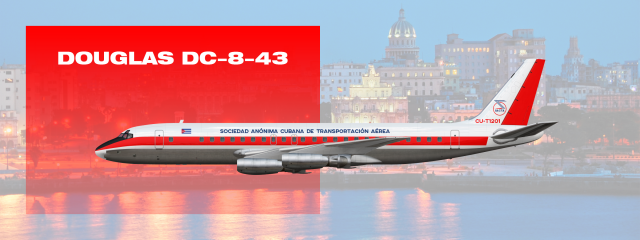
Douglas DC-8 operations in the 1970s
- Owner: Avelo (View all images and albums)
- Uploaded: Mar 07 2021 05:52 PM
- Views: 1,015
- Album SACTA

In the mid-1970s, SACTA began leasing ex-Air Canada Douglas DC-8-43 aircraft for its Canadian, Caribbean, and Guyana services. These aircraft were leased with support from the Canadian government as part of bilateral trade agreements between Canada and Cuba. Canadian Prime Minister Pierre Elliott-Trudeau had spearheaded this initiative himself, seeking to strengthen relations between the two countries. As a result, the Canadian government (and Trudeau himself) came under intense pressure from the U.S. government who disapproved of this initiative and sought to stop it. The DC-8 leases allowed SACTA to gain experience operating U.S.-built jets and made up for delays in deliveries of Soviet-built aircraft. One of the DC-8s (CU-T1200) was damaged in an accident (a mid-air collision with a smaller aircraft) during a test flight with no loss of life, but a second DC-8 (CU-T1201, pictured above) was lost when bombs exploded on board Flight 455 in 1976, resulting in numerous fatalities. The explosions occurred shortly after takeoff from Barbados, whose government had been pressured earlier by the U.S. to cancel SACTA's landing rights. Among the many fatalities was a group of 24 athletes, mostly teenagers, from one of Cuba's sports teams. The Cuban government decried the explosions as sabotage, perpetrated by CIA-trained individuals who sought to damage the airline and terrorize passengers who would fly with SACTA. Consequently, SACTA was forced to screen all passengers and luggage carefully before boarding, requiring lengthy advance check-in times and individual security checks as routine precautions in all flights. Alongside the Britannias, the DC-8s were the only other Western-built aircraft SACTA operated during the 1970s, and their time with the airline was rather short-lived as their leases were cancelled in the latter part of the decade in the aftermath of these incidents.
The logo is giving me very strong Zambia Airways vibes, but it looks very nice! ![]()
Being a bit pedantic... The 'Sociedad Anónima' part in the name of a company should be the last (In this case, CTA, S.A.). Don't think I have ever seen it used in the front of the name.
I agree, this is great
Ecuador's SAETA had those words as the first part of its name (Sociedad Anónima Ecuatoriana de Transportes Aéreos) and so did Belgium's Sabena (Société Anonyme Belge d'Exploitation de la Navigation Aérienne).The logo is giving me very strong Zambia Airways vibes, but it looks very nice!

Being a bit pedantic... The 'Sociedad Anónima' part in the name of a company should be the last (In this case, CTA, S.A.). Don't think I have ever seen it used in the front of the name.
Needless to say, the SACTA logo is an abstract rendering of the Cuban flag in the form of a flying crane in front of a sun, and it's remained largely unchanged since its revolutionary inception in 1959. This airline is my first-ever attempt at creating my own commie brand, and as far as I know, there aren't a lot of successful brands of that kind on AE ¯\_(ツ)_/¯
Ecuador's SAETA had those words as the first part of its name (Sociedad Anónima Ecuatoriana de Transportes Aéreos) and so did Belgium's Sabena (Société Anonyme Belge d'Exploitation de la Navigation Aérienne). Needless to say, the SACTA logo is an abstract rendering of the Cuban flag in the form of a flying crane in front of a sun, and it's remained largely unchanged since its revolutionary inception in 1959. This airline is my first-ever attempt at creating my own commie brand, and as far as I know, there aren't a lot of successful brands of that kind on AE ¯\_(ツ)_/¯
I stand corrected. Didn't think about SAETA and Sabena.
As I said, I think it looks very nice ![]()
ThanksI stand corrected. Didn't think about SAETA and Sabena.
As I said, I think it looks very nice
Damn, this be looking great!

 Sign In
Sign In Create Account
Create Account












